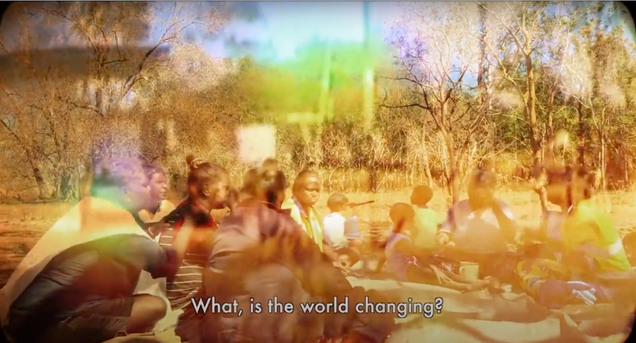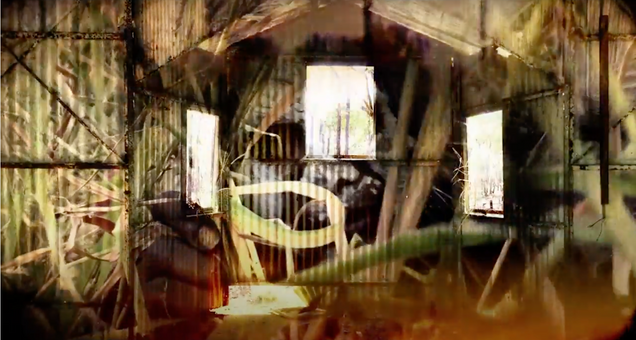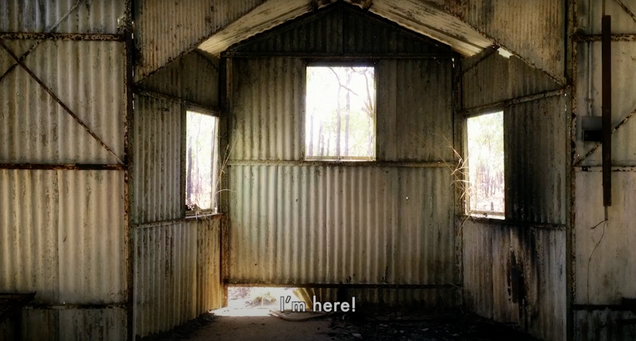Saltwater Dreams, Fragmented Visions: iPhone Aesthetics in the Karrabing Film Collective’s Wutharr, Saltwater Dreams
by Jake Matthews
The world is not only what you make it but how, why, and for whom you make it. For the Karrabing Film Collective, seeing is a generative act in itself. The group was founded in 2013 in the Belyuen community of Australia’s Northern Territory in the wake of heightened policing and incarceration, reduced social welfare, and increased mining activity. The group is a grassroots Indigenous media group that utilizes an “improvisational realism” to expose issues including, but not limited to, state bureaucracy, settler-colonial violence, and environmental degradation.1 Their genre, which is neither strictly fiction nor non-fiction, enables them to counter hegemonic visual histories and propose alternate methodologies through which to imagine the physical environment.
This visualization incorporates ideas of place, ancestry, and temporality. Critical theorist and filmmaker Elizabeth A. Povinelli, who is a cofounder of the group, proposes that the Collective engages with questions of geontology, or, “what difference the difference between Life and Nonlife make[s].”2 This essay will examine how the group addresses both ontological and temporal incongruities not only through their choice of fractured narratives but in their selected medium of iPhone videography. It will consider the group’s 2016 film Wutharr, Saltwater Dreams, their first work to be filmed entirely using an iPhone. More specifically, it will examine the extent to which this format intrinsically lends itself to visual and auditory montage, or synesthesia. Finally, this essay argues that these formal techniques are harnessed to explicate the ubiquitous effects of settler-colonial violence, on one hand, and the utopian potential of fragmentation, on the other.
Wutharr is a 29-minute film centered around a simple question: what caused a boat motor to break down on a journey to Karrabing’s remote country? Several members of the Belyuen community, including Trevor and Rex, had taken the boat, owned by Linda Yarrowin, on voyages to collect water and to fish in previous days. Three alternate perspectives are presented by Rex, Trevor, and Linda, although these often exist in the same frame.3 The fractured nature of these positions and their ontological origins are explicated through superimposed images of contemporary subjects, land, and historical events. In Rex’s account, the reason for the breakdown is simply that the boat’s wiring needs changing: “I don’t know about Lord but I know about wiring.” Trevor, meanwhile, maintains that their ancestors are punishing them. Thirdly, Linda believes that the situation is a test of her Christian faith: “If you have faith in the Lord [the motor] will start.”4 Outside of these three oral accounts, structural forces are at play. As a group of characters passes time in a front yard, a state official approaches and hands Linda a set of forms that must be completed for not satisfying the safety requirements of lighting a safety flare. The documents require firm “yes” or “no” responses, although the group does not agree that such definitive answers can be provided. At another point, Trevor and his boat crew encounter a white character, Jack, who contradicts their rights to land ownership: “I’m not on your f*cking country, I’m on the saltwater.”
The multiple narratives within Wutharr suggest that in order to make any ontological determination, one must consider the living, non-living, human, and non-human across multiple temporalities. In its visual language, the film establishes connections between these seemingly distinct entities. In Trevor’s account of the story, as the group walks to collect drinking water, he warns of a bad omen: “That crow is singing out. That’s not a good sign.” Subsequently, nyudj (ancestral spirits) demand that the group be punished (figs. 1, 2): “They never visit us. Let’s go make trouble for them.” Superimposed on the faces of the nyudj are fragments of plant life and reflective streams of light. These moments exist within the same frame, where the bodies of the film’s protagonists become entangled with non-human forms, ancestral figures, and other, often unidentifiable visual material. Different registers of time—historic, ancestral, and geologic—materialize, overlap, and recede.


If, on a narrative level, Wutharr proposes an alternative means of comprehending one’s ontological capacity, what does this approach look like? Cultural theorist Nicholas Mirzoeff describes countervisuality as having three constituent aspects: “a claim to move out of the ‘place’ allocated to one by birth, a claim to democracy, … and a means of sustaining these claims beyond the spontaneous moment of uprising.”5 The Karrabing Film Collective’s use of multiple narratives and layered imagery underscores a connection between ontology, epistemology, and visuality. The Collective refuses any singular source of knowledge and being, and also rejects the production of a singular visual field. In Linda’s account, the group sits outdoors and discusses its relationship to both their ancestors and Christianity. Images of a scorched, de-solidified ground at times overlay the faces of the group members. Archival footage from Christian missions, which orchestrated the removal of Indigenous children from communities between approximately 1905 and 1967, is entangled in the flames and dried earth. “What year is this? 1952?” someone asks. “No! It’s 2015” responds another. “What? Is the world changing?” (fig. 3). In Wutharr, the juxtaposed images and dialogue establish the temporal interdependence of these threats. The destruction of the environment is a threat to existence as is the legacy of child removal policies and missionary Christianity. Here, the Collective’s countervisual strategy demonstrates that it is impossible to segregate issues of anthropogenic climate change from the legacy of colonial violence and from the everyday, comparatively mundane experience of existing in one’s environment.

Wutharr is the first of the Karrabing Film Collective’s works to have utilized the iPhone as their primary filming technology. In 2016, the Collective’s members began completing their own cinematography and adopted a more organic schedule closer to the pace of home movies. The utilization of the iPhone achieves two things. Firstly, it narrows the spatial and temporal distance between the filmmaker and the world, facilitating improvisation. Secondly, and perhaps most critically, it enables the filmmakers’ environment to be fragmented even further. The small, tactile camera allows the filmmakers to get closer to the ground, to capture details more intimately, and to edit and splice material rapidly.

In other ways, the Karrabing Film Collective makes use of the iPhone for the aesthetic qualities that it facilitates. Wutharr is not necessarily a rebuke to the linear narratives of mainstream cinema, but it signifies the development of an alternate realism that utilizes the language of fragmentation. With the ability to rapidly shoot and review content, get closer to their subjects and environments, and quickly transfer video files, the Collective is better able to layer and splice seemingly disparate images to produce a continuous narrative. Formally, this approach incorporates aspects of rhythmic montage, or the editing of shots based on their visual content. There is a scene in Wutharr, for example, in which shots of the group are juxtaposed with another shot depicting fragments of the state official’s uniform (fig. 4). Yet more crucially, one can think of the Collective adopting montage on a theoretical level. In “A Dialectic Approach to Film Form,” film director and theorist Sergei Eisenstein stipulates that montage is “the idea which arises from the collision of independent shots.”6 He conceptualizes a form of vertical montage, concerned with single moments rather than their relation in a sequence, that cannot be traced in the static frame nor the musical score, but only “in the dynamics of the musical or cinematic process.”7 It is this kind of synesthesia, or play between visual and non-visual phenomena, that also characterizes the Karrabing Film Collective’s experimentation with the iPhone camera.
This sort of formalized synesthesia is evident in the final scenes of Wutharr. Visually, a later scene is produced, as a shot of an eroding metal structure, perhaps a shed, responds to the closeup shot of the ancestor amongst the grass (fig. 5). This site and those encountered by the film’s protagonists are forever entwined with the living and the non-living, the organic and the inorganic, the now and the then. The soundtrack of this short scene is a continuation of the dialogue, song, church bells, and instruments that accompanied Linda’s account of the story. In this way, the Collective produces a synesthesia that enmeshes the sonic qualities of the previous scene with different visual fragments, altering the framing of the narrative. In the last second of the scene, the shot of the ancestor disappears, leaving only the image of the metal structure and the sound of the group from the earlier scene. A voice shouts “I’m here!” as the scene fades to black.


The adoption of vertical montage or synesthesia, facilitated by the tactility and adaptiveness of the iPhone camera, presents the environment as a network of connections. Landscapes and matter are transformed and exist within an entangled world. Film theorist May Adadol Ingawanij notes a dialectical aspect to this approach, too, as state bureaucracy, environmental crisis, and social inequality all shape the lives of the film’s Indigenous characters:
There is no outside of the everyday time of settler late liberal violence, yet that time of routinized administrative denial of life beyond the bare survival of Indigenous subjects intersects with and rubs against multiple other temporal scales, the deep time of partially connected and at times rivaling versions of ancestral dreaming with the deep time of geological change and the accelerated time of capitalist extraction.8
Thus, the process of seeing is inherently bound to both external forces, contemporary and historic, and specifically Indigenous ontologies. Wutharr, Saltwater Dreams is utopian in its presentation of recalibrated ecological and social exchanges. To return to Mirzoeff’s idea of countervisuality, the Collective’s filmmaking facilitates a movement away from the structural forces that constrain Indigenous ways of seeing, acts as a claim to democracy, and will exist beyond the moment of unrest that resulted in the group’s formation. The film is dystopian, however, in its insistence that Indigenous bodies can never be detangled from the persistent legacy of settler-colonialism and environmental destruction. Rather than visualizing an entirely new future, the Karrabing Film Collective presents a heterogeneous means of seeing. This presents a new method of visualizing temporal incongruities of a historical, ancestral, and geological nature as well as the environment, encompassing the living and the non-living, both away from and within view of the settler state. There is both pain and power in perceiving all of this at once.
____________________
Jake Matthews
Jake Matthews is a recent graduate of the School of the Art Institute of Chicago. At a broad level, his research is focused on the politics of visuality and medium-specificity. His recent work has considered Indigenous issues of video and new media as responses to environmental degradation and state violence.
____________________
Footnotes
1. Visibleproject, “Karrabing Is Not a Clan, Not a Language Group, Not a Nation. It Is an Aspiration – Elizabeth Povinelli in Conversation with Martina Angelotti on the Karrabing Film Collective, Winner of the 2015 Visible Award,” November 25, 2014. https://www.visibleproject.org/blog/elizabeth-povinelli-in-conversation-with-martina-angelotti-on-the-karrabing-film-collective-winner-of-the-2015-visible-award/.
2. Elizabeth A. Povinelli, “Geontologies: The Concept and Its Territories,” e-Flux no. 81, (April 2017): 3.
3. In an interview with Vdrome, the Collective state that “Wutharr begins and insists throughout that Indigenous families are not homogenous cultural machines but are composed of complex points of view… All three points of view exist in the same frame.” See Vivian Ziherl, “Karrabing Film Collective: ‘Wutharr, Saltwater Dreams,’” Vdrome, 2016. https://www.vdrome.org/karrabing-film-collective-wutharr-saltwater-dreams.
4. Before 1975, the recognized Indigenous community of Belyuen was known as Delissaville. Beginning in 1825, the Church Mission Society, among others, arrived to establish Christian missions that targeted Indigenous communities.
5. Nicholas Mirzoeff, “Visualizing the Anthropocene,” Public Culture 26, no. 2 (2014): 213–32.
6. Sergei Eisenstein, “A Dialectic Approach to Film Form,” Film Form (1949): 4.
7. Peter Thompson, “Eisenstein’s Montage Theories,” Eisenstein’s Film Essays, accessed December 22, 2020. http://www.chicagomediaworks.com/2instructworks/3editing_doc/3editingeisenstein.html.
8. May Adanol Ingawanij, “Comedy of Entanglement: Karrabing Film Collective,” Afterall 48, no. 1 (2019): 33.